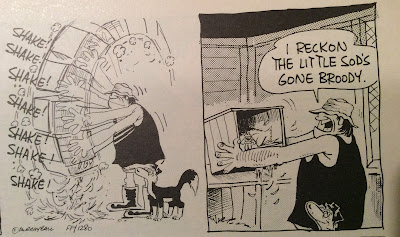We originally believed much of the information on the web, and thought that quail really were unable to hatch and raise their own chicks - the instinct having apparently been "bred out of them" in order to get as many eggs as possible for human consumption. Pretty much every website tells you what wonderfully productive layers these little birds are, but at the same time, we are also told they cannot hatch their own babies and anyone wanting to breed them will need an incubator.
And presumably because quail are small, considerably smaller than a "standard" chook (such as an Australorp or an Orpington), it is thought they don't need a large coop, and can be happily kept in cramped conditions in wire cages a bit like rabbit hutches.
 |
| Overcrowded quails in a non-natural setting |
Having watched our birds wander around our garden for a full year now, it seems abundantly clear that the breeding instinct is well and truly present, and the single most likely factor in a non-breeding bird is the tiny enclosures in which they are often housed. Putting a dozen or more birds in a small aviary or cage, with little or no access to natural soil, and grass, and insects, and no ability to stake out territory, or pair with a suitable mate, or find a hidden place to lay a clutch, and with the eggs removed each day...it's not really that surprising that the birds don't go broody!
Not everyone has a big backyard or can build a massive quail enclosure - but many people across Tasmania, and elsewhere, already have enclosed veggie gardens. It would be fantastic if more quails were living in gardens like this, instead of being kept in tiny hutches. A "chook tractor" design would also work - anywhere that gives the birds greenery and insects and light and places to hide. A brood of naturally-hatched quail chicks being raised by their parents are one of the most delightful things you'll ever see!
 |
| Goldie and her first little one |
A broody quail does not behave like a broody chook. They do not stubbornly sit on a single egg, becoming aggressive if you approach the nesting box, making it clear they want to start a family...
 |
| Cartoon image courtesy of Footrot Flats (copyright Murray Ball) |
 |
| Goldie - our first broody girl - in the grass under a nectarine tree |
They will stay completely still unless the other birds come too close - particularly the males - and then they will fly off and drive the males away. During Spring - when most of our birds started sitting - the males can be particularly aggressive, pestering the females almost continually. We ended up putting our dominant male in solitary confinement for a while, just to give the sitting mother some peace. Once the chicks were hatched, the male was allowed back in the garden with the others, and he didn't give any more trouble. The mother didn't give him a chance - they are very protective of their chicks.
Apart from space, privacy and comfort, a male to fertilise the eggs, and patience and determination on the part of the mother, quails don't seem to need much else to breed. We really believe that any quail will go broody, given enough room. Have a go - we'd love to hear from other people who may have found the same thing happen, or are interested in trying to raise chicks naturally.








